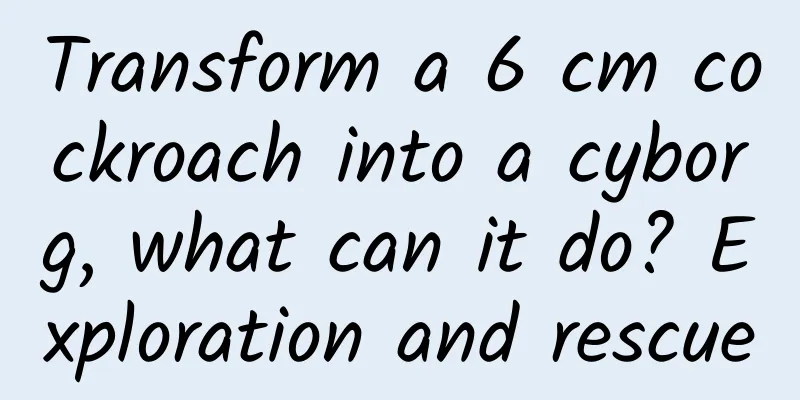Transform a 6 cm cockroach into a cyborg, what can it do? Exploration and rescue

|
Cyborg, this term often appears in science fiction works, and it means "mechanized organism". Cyborg is different from ordinary robots. It is a combination of machinery and organisms. Unlike ordinary robots, it is not controlled by programs or others. Its thinking and behavior are completely controlled by its own organism. In science fiction works, cyborgs usually appear as transformed humans, but it is difficult for us to do this in reality. So scientists focus on animals, such as a large cockroach about 6 cm long. Transforming cockroaches into cyborgs? This sounds a bit ironic, but this thing has great prospects. The Madagascar cockroach is a large cockroach that is only distributed on the African island of Madagascar. Its body length is between 5 and 7 cm. When it comes to cockroaches, most people don't have a very good impression of them, especially large cockroaches. Many people will be afraid of them when they think of them, but worldwide, the Madagascar cockroach is still quite popular because it is one of the most common pet cockroaches. This cockroach has a strong climbing ability, but it has no wings, so it can't fly, which is why scientists like it. Like other cockroaches, Madagascar cockroaches also have a freely retractable exoskeleton, which means they can move freely in a small space by squeezing their bodies. This is difficult to match with any small robot of similar size. Coupled with their excellent climbing ability and movement speed, they are definitely good at exploration and search and rescue. Transforming cockroaches into cyborgs is a very creative idea, but there are also some problems. The movements of cockroaches are uncontrollable, and they are not moving and exploring all the time, so we must find ways to improve their exploration efficiency. So a group of researchers from Osaka University in Japan came up with the idea of using electrode stimulation plus AI control to enhance cockroaches' ability to explore unfamiliar areas. Scientists have previously discovered that cockroaches are very sensitive to electrode stimulation. When the left tail of the cockroach is electrically stimulated, it will turn right. If the right tail is electrically stimulated, the cockroach will turn left. If both are stimulated at the same time, the cockroach's movement speed will be significantly accelerated. Of course, the researchers do not intend to use this research result to turn the cockroach into a remote-controlled machine. They want to retain the cockroach's free movement and use the cockroach's own ability to explore unfamiliar environments to complete the exploration and search and rescue missions in small spaces. To achieve this goal, the scientists implanted three platinum electrodes in the cockroaches, one on the chest and the other two on the left and right cerci. Next, the researchers put a backpack on the cockroaches. Since Madagascar cockroaches have no wings, it is very easy to install the backpack. The backpack is equipped with an inertial measurement unit that can measure the cockroaches' acceleration and angular velocity. Then, a machine learning algorithm is used to analyze the data to conclude whether the cockroaches have stopped moving. If the cockroaches are found to have stopped moving, electrode stimulation will be activated to get them moving again. Why go to all this trouble? Wouldn't it be enough to just let the electrodes intermittently send stimulation signals to the cockroaches? Cockroaches are not machines, they are living things. Continuous stimulation will cause them to become overly fatigued. Therefore, only after confirming that the cockroaches have completely stopped can they be given the right amount of stimulation to improve their exploration efficiency. According to the experimental results, the cockroaches that received electrical stimulation according to the guidance of AI increased their regional search rate by 68% within a certain period of time, increased their walking distance by 70, and reduced their rest time by 78%. In addition, the cockroaches did not suffer from excessive fatigue due to the reduction in rest time. In the future, scientists are considering letting cockroaches carry a biofuel cell, using the trehalose in the cockroach's body fluids to generate electricity to power the intelligent system. In this way, the cyborg cockroaches will be able to complete long-term exploration and search and rescue missions. |
<<: If you sleep in this position, your body will soon become exhausted!
>>: Can you make up for your sleep debt?
Recommend
China Unicom, Baidu and Huawei jointly carry out autonomous driving demonstrations using 5G technology, bringing the Internet of Vehicles one step closer to implementation
On September 27, China Unicom, Baidu and Huawei c...
Efficient customer acquisition | Teach you how to achieve "high-quality" new customer acquisition through data
Almost all operational work is carried out around...
[Smart Farmers] Spring is here and farming is busy | From south to north, a satellite view shows the colorful land getting ready for farming
"Spring plowing land early" Spring plow...
What are the impressions, clicks, click-through rates, and rankings that appear in traffic and keyword tools?
With the arrival of 2018, I have been working in ...
How to prevent aerosol transmission at home?
END Editor: Guru...
Anhui Jinzhai Red Education Base
Anhui Jinzhai Red Education Base training consult...
The United States announced that it has begun to develop 6G. Is this leapfrog development reliable?
The US government has been concerned about losing...
We may find the secret to preventing cancer from elephants and blue whales
Cancer is essentially a disease caused by gene mu...
Get a full refund from VATTI World Cup, and talk about the 5 correct approaches to new media marketing
The World Cup is over, France won the championshi...
Tsinghua Unigroup may acquire Apple's GPU supplier, and now it will have its own CPU and GPU
On April 3, Apple announced that it would stop us...
What should I do if the information flow delivery effect is not good? Just need to understand these 4 data!
How to play information flow advertising ? Who sh...
How to get the Taobao Live invitation code? What are the tips for Taobao Live?
This article mainly introduces how to obtain the ...
The method used by BAT, detailing the pitfalls of A/B testing!
An important idea mentioned in the growth hacker ...
Essential for overseas promotion: What are the global advertising channels?
AppsFlyer breaks down data by industry verticals ...
After making groundbreaking contributions, she was "rescued" by the 2024 Lasker Award
Among the three winners of the 2024 Lasker Clinic...









